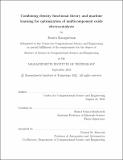Combining density functional theory and machine learning for optimization of multicomponent oxide electrocatalysts
Author(s)
Karaguesian, Jessica
DownloadThesis PDF (7.268Mb)
Advisor
Gómez-Bombarelli, Rafael
Terms of use
Metadata
Show full item recordAbstract
Multicomponent metal oxides, such as perovskite oxides, hold promise for use as sustainable alternatives to Ir-, Ru-, and Pt-based electrocatalysts at scale. Perovskites can accommodate a wide variety of elements in their A- and B-sites, enabling tuning of their structural and electronic properties through compositional alloying. These properties, which are obtainable from density functional theory (DFT) calculations, can be used as low-dimensional descriptors that correlate with experimental stability and activity in, for example, the oxygen evolution reaction (OER). Established descriptors of stability include energy above convex hull and energy above Pourbaix hull, while those for catalytic activity include oxygen 2p- and B-site metal d-band centers, for example. We are therefore presented with a combinatorial problem of determining which A- and B-site compositions optimize such descriptors. The compositional search space of 𝐴ₓ𝐴′₁₋ₓ𝐵ᵧ𝐵′₁₋ᵧ𝑂₃ perovskites with up to two different elements in A- and B-sites is at least 𝑂(10⁶), making it intractable to calculate descriptors exhaustively using DFT. We therefore combine high-throughput DFT calculations with crystal-based graph neural networks to screen multicomponent perovskites. Using a high-throughput virtual screening platform, a DFT-simulated dataset of over 5,000 multicomponent perovskites was generated, with varied A- and Bsite alloying ratios and over 3,000 unique cationic combinations. Leveraging this dataset, alongside calculations available in the literature, graph convolutional neural networks (GNNs) were trained to predict the aforementioned crystal descriptors from unrelaxed cubic structures and used to predict descriptors for 𝑂(10⁶) 𝐴ₓ𝐴′₁₋ₓ𝐵ᵧ𝐵′₁₋ᵧ𝑂₃ perovskites. GNNs were also combined with baseline estimates of multicomponent perovskite properties calculated as interpolations of constituent 𝐴𝐵𝑂₃ perovskites, thereby achieving improved model performance. Moreover, impacts of varied cationic ordering were modelled, showing that different decorations of cations within the perovskite lattice can modulate resulting properties to the same degree as—or more than—varying compositional ratios. Equivariant message passing neural networks were thus implemented to achieve cation decoration-aware property predictions. Lastly, GNNs predicting per-site properties were established, encoding local chemical environments to provide physical insights about each atom in a crystal lattice. The presented work provides the community with a benchmark multicomponent perovskite dataset, improved machine learning models, and physical insights to be used in further studies of alloyed perovskites, and thus lays groundwork for improved design of multicomponent oxide electrocatalysts.
Date issued
2022-09Department
Massachusetts Institute of Technology. Center for Computational Science and EngineeringPublisher
Massachusetts Institute of Technology